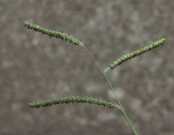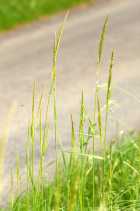Grasses

This is a list of grasses/crops that are used as pastures and are generally considered safe for stock with some caveats. In some instances
under certain circumstances these plants may be toxic i.e. immature or stressed Sorghum (Prussic acid) and under certain conditions other grasses
can become toxic under conditions of stress, to much nitrogen, mould, bacteria or fungus for instance
Rye Grasses may be toxic
each accompanying link has a reference near the bottom of the page regarding Livestock disorders/toxicity.
Identifying grasses is not an easy task . This is a good site for grass identification this is also
useful in identifying Common Range Plants
A-B-C-D-E-F -G-H-I-J-K -L-M-N-O-P -Q-R-S-T-U -W-X-Y-Z -Toxic
Common Name
Safe GrassesA
African lovegrass
Aleman grass
Alsike clover
American jointvetch
Angleton grass
Arrowleaf cloverB
Bahia grass
Balansa clover
Ball clover
Bambatsi panic
Barley Mitchell grass
Barrel medic
Berry saltbush
Berseem clover
Biennial/short-lived hybrid ryegrass
Birdsfoot trefoil
Biserrula
Bladder clover
Blue lupin
Blue pea
bluebush
Bokhara clover
Brachi
Brachi hybrid
Brachiaria hybrid
Brachy sub clover
Brazilian centro
Brizantha
Brunswick grass
Buffel grass
Bull Mitchell grass
Bullrush millet
Burgundy bean
Butterfly pea
Button medicC
Caatinga stylo
Caucasian clover
Centro
Centurion
Chicory
Chou Moellier
Cloncurry buffel grass
Cluster clover
Cocksfoot
Common vetch
Corn
Cowpea
Creeping bluegrass
Creeping saltbush
Creeping vigna
Crimson clover
Curly Mitchell grassD
Desmanthus
Digit grass
Disc medic
Dual purpose wheatE
Eastern star clover
English plantain
Eqyptian clover
Evening primroseF
Fine stem stylo
Finger grass
Fodder kale
Forage oats
Fonio (digitaria exils and digitaria ibura)
Forage sorghum
Forest bluegrass
French serradella - hard seeded
French serradella - soft seededG
Gama medic
Gatton panic
German grass
Gland clover
Glycine
Grazing bromegrass
Greater lotus
Green panic
Greenleaf desmodium
Guinea grassH
Hamata
Honey clover
Hoop (Weeping) Mitchell grass
Hubam clover
Humidicola
Hybrid disc medic
Hybrid ryegrass (short-lived types)
Hybrid/biennial ryegrassI
Indian Bluegrass
Italian ryegrass (biennial types)
Italian ryegrass (Queensland term)
Italian/Annual ryegrassK
Kale
Kangaroo grass
Kikuyu
Koronivia grassL
Lablab
Leucaena
Lotononis
LucerneM
Maize
Mediterranean saltbush
Millet
Mitchell grassesN
Narrow-leaved plantain
Native scurf peaO
Oats
Old man saltbushP
Pangola grass
Panics
Para grass
Pasture brome grass
Pearl millet
Perennial forage sorghum
Perennial ryegrass
Perennial veldt grass
Persian clover (ssp. majus)
Persian clover (ssp. resupinatum)
Phalaris
Pinto peanut
Plantain
Poa labillardierei tussock grass
Prairie grass
Puccinellia
Purple clover
Purple pigeon grass
Purple vetchQ
Queensland BluegrassR
Rape, Radish and Hybrid rape
Red clover
Rhodes grass
Ribwort
River saltbush
Rose clover
Round-leaf cassia
Ruby saltbushS
Sabi grass
Scabra
Serradella: French
Serradella: yellow
Setaria
Shrubby stylo
Signal grass
Silverleaf desmodium
Siratro
Slender serradella
Small leaf bluebush
Snail medic
Sorghum
Sphere medic
Spineless burr medic
Strand medic
Strawberry clover
Stylo
Stylo; Caribbean stylo
Sub clover
Subteranean/Sub clover (ssp. brachycalicinum)
Subterranean/Sub clover (ssp. subterraneum)
Subterranean/Sub clover (ssp. yanninicum)
Sulla
SwedeT
Tagasaste
Talish clover
Tall fescue
Tall finger grass
Tall scurf pea
Tall verbine
Tall wheat grass
Timothy
Tree lucerne
TurnipV
Villose jointvetchW
Wallaby grass (Austrodanthonia bipartita, A. richardsonii)
Wallaby grass (Austrodanthonia caespitosa)
Weeping grass
Weeping rice grass
White clover
White melilot
White sweet clover
Wimmera/Annual ryegrass
Woolly pod vetch
Wynn cassiaY
Yanga bush
Yann sub clover
Yellow serradella
Potentially toxic grasses
Include Arrowgrass, Dallis Grass, Fescue, Johnson Grass, Klein Grass, Squirreltail Grass, Yellow Bristle Grass, Yellow Oatsgrass and Horsetails . This is a good site for grass identification>Arrowgrass has prussic acid in its leaves and can have a high cyanide content, depending on the
location and conditions under which it's grown. It's recorded to be potentially
lethal to animals at .5 percent of their body weight. Signs of poisoning:Symptoms o
f arrowgrass poisoning are typical of cyanide poisoning: excitement, rapid respiration, weakened pulse, tachycardia, salivation, voiding of urine and feces, staggering, collapse,
bright-red mucous membranes, convulsions, and death.

>Dallis grass Paspalum dilatatum-Poaceae,Grass Family
Similar species:Rye Grass;Lolium perenne(withErgotfungus,Clavicepsspecies).
Description:Dallis grass is a common perennial grass that may grow as tall as 40
inches under the right conditions. The blades are flat, coarse, and have pointed
ends. Little hairs grow at their base, and dozens of tiny oval seeds grow up the
stem.
Rye grass is a coarse green annual or perennial grass with a spiked end, similar
to dallis grass, but it grows only to about 25 inches tall. Its seeds, which
grow up the side of the plant, are somewhat flatter and less sparse than those of
the dallis grass.
Frequently, a parasitic fungus invades the flower heads, producing "honey dew."
Insects are attracted to the secretion and help in transmitting the fungus.
This fungus produces lysergic acid derivatives, ergotamine, and ergotoxine,
affecting animals that ingest it. The endophytic fungus (Acremonium lolii)
that invades rye grass produces a tremorgenic toxin that induces muscle tremors.
Signs of poisoning:Symptoms include nervousness; trembling; staggering;
abortion; convulsions; blood-vessel restriction causing nerve damage in
the tail, ears, and other limbs; lameness; and gangrene. These symptoms
occur within several days to several weeks of ingestion. Cattle are more
commonly involved in dallis or rye grass poisoning, but other animals,
including horses, may also be susceptible.

Fescue
Festucaspecies-Poaceae,Grass Family
Description:Chewings fescue,Festuca rubra, grows to three feet tall and has round,
wiry leaves that grow in tufts at the base of the plant. Nematode galls are often
found in the seed and have produced toxic symptoms in horses after they ingest
either the seed or the grass. Coryne toxins are the toxic principle.
Tall fescue,Festuca arundinacea,is a drought-resistant, coarse perennial
grass that thrives in wet areas and is often grown for forage. It has a long,
flat, ribbed, dark-green blade, and can grow up to four feet. It bears many small
flowers on one-foot spikes. The plant contains alkaloids, perloline, and
halostachine. An endophyte fungus is known to infect fescue and is important to
the development of toxicity to animals grazing the grass.Signs of poisoning:With
chewings fescue poisoning, muscle trembling, ataxia, staggering and falling,
abortions, and death have all been noted, with degeneration of liver and kidneys
in chronic cases.
Tall fescue poisoning occurs after several days to several months of grazing
endophyte-infected fescue. Symptoms may vary depending upon the time of the year:
In winter, lameness, diarrhea, anorexia, rough haircoat, and possible gangrene of
the tail, hooves, and ears may appear. Poor growth rates and weight loss may
occur. In summer, animals may have elevated temperatures, and females have little
milk for their young. Stillbirths, abortions, prolonged gestations, retained
placentas, and infertility are frequent in mares. Foals may have very long hooves
if they survive birth due to the prolonged gestation. Fescue infected with the
endophyte Neotyphodium coenophialum (formerly known as Acremonium coenophialum)
is known to produce many ergopeptide alkaloids. Most of the toxic effects of
fescue are now attributed to ergovaline, a specific ergopeptide alkaloid.



Johnson Grass
Sorghum halepense -Poaceae,Grass Family
Similar species:Columbus Grass; Sorghum;Sorghumspecies; Sudan grass;Sorghum
vulgare.Both Johnson and Sudan grasses may contain hydrocyanic acid (prussic acid)
and sometimes toxic levels of nitrates. Toxicity is highest in young plants and
lowest when the plant is yellow, more than two feet tall, and forming fruiting
heads. The levels of cyanide increase when the plant is stressed, for example
during drought or frost. Leaves have a higher concentration of cyanide than stems.


Kleingrass
Panicum coloratum-Poaceae, Grass Family
Similar species:Panicum vitgarum.
Description:Kleingrass is a perennial with narrow blades and looks similar
to coastal grass (the hay of choice in Texas). Look for bunches of small seeds
at the tops to help identify it. Kleingrass grows up to four feet tall and bears small spiklets on its tops at maturity.
The toxic principle is believed to be saponin, but it's not found in the same
quantities in all plants. Although the grass has a strange smell, it may be
eaten by hungry horses when no other forage is available. Kleingrass hay is
also toxic. The seed provides a good food source for game birds and the foliage
provides cover and shelter for small game birds
such as quail and dove.


Squirreltail Grass
Hordeum jubatum-Poaceae, Grass Family
Also known as:Foxtail Grass, Wild Barley.
Signs of poisoning:The grass may pierce the skin on the animal's ears,
neck, face, or mouth, causing abscesses, ulcers, possible blindness,
and the inability to eat. It may cause colic and impaction in horses.


Yellow Bristle Grass
Setaria Lutescens -Poaceae, Grass Family
Also known as:Foxtail Grass; Pigeon Grass.
Yellow bristle grass doesn't contain toxins, but it's a poor forage for
animal consumption. It has little spikes and wiry bristles with tiny barbs
on the ends that cause mechanical injury to an animal's oral tissues.



Yellow oatgrass or golden oatgrass, Trisetum flavescens,
is a species of grass in the Poaceae family. It is native to Europe, Asia, and North Africa.
It can be found elsewhere, such as sections of North America, where it was introduced as
a rangeland grass for grazing. It now exists in the wild as a common weed.
In Austria and Germany, T. flavescens is a common component of alpine pasture and
is associated with the onset of signs about 18 months after cattle are put onto the
infested pasture. Resident cattle show clinical signs at about 3 years of age.
The grass is most toxic when it is young, and the clinical signs are worse when
the cattle are at pasture.
Pathogenesis
The glycoside ingested in the plant is hydrolyzed by rumen microbes, intestinal
mucosal enzymes, and bone cells to form the vitamin D3 analog. Absorption of the
active substance results in a dramatic increase in the uptake of calcium from the diet.
Blood levels of calcium are markedly increased, and this is followed by deposition of
calcium in soft tissues.
The mode of action of the glycoside is similar to that of 1,25-dihydroxycholecalciferol.
Recent studies have confirmed that the toxin is in fact Vitamin D3. Trisetum flavescens,
has joined a list of plants now known to contain active VD3.
Science direct
This plant and other plants containing calcinogenic glycosides are unlikely toxic to captive
birds if fed at less than 10% of a balanced diet. The effects of VD toxicity is described here
Vitamin D
Properties and Metabolism

Horsetails
Equisetum arvense -Equisetaceae,Equisetum Family
Also known as:Foxtails; Scouring Rushes.
Description:Horsetails have windswept-looking whorls of thin, grasslike
leaves at the ends of the many tall, green, segmented hollow stems, resembling
a horse's tail. They're reported to be poisonous to all classes of livestock,
although horses appear to be most susceptible.
The plant contains toxic aconitic acid, palustrine, and thiaminase. Horses
have shown various degrees of poisoning after consumption, and young horses
are more likely to succumb than older horses. Toxicity is higher in green
plants than in aged plants.

